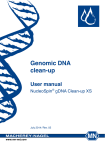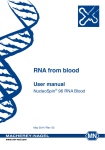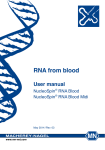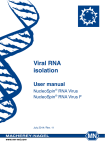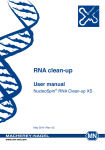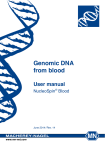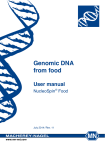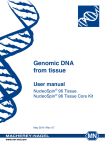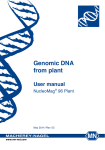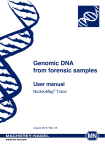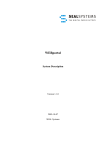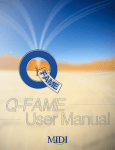Download Small RNA and DNA from Plasma User manual
Transcript
Small RNA and DNA from Plasma User manual NucleoSpin® miRNA Plasma July 2014 / Rev. 03 Isolation of miRNA from plasma Protocol-at-a-glance (Rev. 03) NucleoSpin® miRNA Plasma 1 300 μL plasma or serum* Prepare sample 90 μL MLP Vortex 5 s RT, 3 min 2 Precipitate protein 30 μL MPP Vortex 5 s RT, 1 min 11,000 x g, 3 min 3 Transfer supernatant 4 Adjust binding conditions 5 Bind RNA and DNA Transfer clear supernatant to Collection Tube (2 mL, lid) 400 μL isopropanol Vortex 5 s Load sample on NucleoSpin® miRNA Column RT, 2 min 11,000 x g, 30 s 6 Optional: Digest DNA Optional: 1st 700 μL MW2 11,000 x g, 30 s 2nd 250 μL MW2 11,000 x g, 2 min 50 μL rDNase in Reaction Buffer for rDNase RT, 15 min 7 8 Wash and dry Elute RNA 1st 100 μL MW1 11,000 x g, 30 s 2nd 700 μL MW2 11,000 x g, 30 s 3rd 250 μL MW2 11,000 x g, 2 min 30 μL RNase-free H2O RT, 1 min 11,000 x g, 1 min * Larger sample volumes can be processed when buffer volumes of MLP, MPP, and isopropanol are increased proportionally. Multiple loading is necessary in step 5 (see section 2.3 for more information). MACHEREY-NAGEL GmbH & Co. KG · Neumann-Neander-Str. 6–8 · 52355 Düren · Germany Tel.: +49 24 21 969-270 · Fax: +49 24 21 969-199 · [email protected] · www.mn-net.com Small RNA and DNA from plasma Table of contents 1 Components 4 1.1 Kit contents 4 1.2 Reagents, consumables, and equipment to be supplied by user 5 1.3 About this user manual 5 2 Product description 6 2.1 The basic principle 6 2.2 Kit specifications 6 2.3 Amount of starting material 7 2.4 Proteinase K digest 8 2.5 Addition of carrier 8 2.6 Elution procedures 8 3 Storage conditions and preparation of working solutions 9 4 Safety instructions 10 5 Protocol – small RNA and DNA purification from plasma or serum 12 6Appendix 16 6.1Troubleshooting 16 6.2 Ordering information 17 6.3 Product use restriction / warranty 18 MACHEREY-NAGEL – 07 / 2014, Rev. 03 3 Small RNA and DNA from plasma 1 Components 1.1 Kit contents NucleoSpin® miRNA Plasma 10 preps 50 preps 250 preps 740981.10 740981.50 740981.250 Lysis Buffer MLP 3 mL 13 mL 75 mL Protein Precipitation Buffer MPP 5 mL 5 mL 25 mL Reaction Buffer for rDNase 7 mL 7 mL 30 mL 1 vial (size C) 1 vial (size C) 5 vials (size C) Wash Buffer MW1 10 mL 10 mL 35 mL Wash Buffer MW2 (Concentrate)* 6 mL 25 mL 2 x 50 mL RNase-free H2O 13 mL 13 mL 13 mL NucleoSpin® miRNA Columns (green rings) 10 50 250 Collection Tubes (1.5 mL) 10 50 250 Collection Tubes (2 mL) 10 50 250 Collection Tubes (2 mL, lid) 10 50 250 User manual 1 1 1 REF rDNase, RNase-free (lyophilized) * For preparation of working solutions and storage conditions see section 3. 4 MACHEREY-NAGEL – 07 / 2014, Rev. 03 Small RNA and DNA from plasma 1.2 Reagents, consumables, and equipment to be supplied by user Reagents • • 96–100 % ethanol Isopropanol Consumables • RNase-free disposable pipette tips Equipment • Manual pipettors • Centrifuge for microcentrifuge tubes • • Vortexer Personal protection equipment (lab coat, gloves, goggles) 1.3 About this user manual It is strongly recommended that first-time users of the NucleoSpin® miRNA Plasma kit read the detailed protocol section of this user manual. Experienced users, however, may refer to the Protocol-at-a-glance instead. The Protocol-at-a-glance is designed to be used only as a supplemental tool for quick referencing while performing the purification procedure. All technical literature is available on the internet at www.mn-net.com. MACHEREY-NAGEL – 07 / 2014, Rev. 03 5 Small RNA and DNA from plasma 2 Product description 2.1 The basic principle The NucleoSpin® miRNA Plasma kit offers the unique feature to isolate small RNA and DNA from plasma without the need to resort to the cumbersome phenol / chloroform extraction or a time consuming proteinase digest. The sample material is denatured in Lysis Buffer MLP. The protein is then precipitated by Protein Precipitation Buffer MPP and pelleted by centrifugation. After the removal of protein the binding conditions for nucleic acids are adjusted by adding isopropanol. The small RNA and DNA are bound to the NucleoSpin® miRNA Column. Optionally, DNA can be removed by an on-column rDNase digest. The remaining nucleic acids are washed and eluted with minimal amounts of RNase-free water. 2.2 Kit specifications • The NucleoSpin® miRNA Plasma kit is designed for the isolation of short RNA and DNA (< 1000 nt/bp) from cell free blood plasma or serum. • rDNase is provided for an optional on-column digest to remove traces of genomic DNA. • The eluted RNA and DNA are ready-to-use for all standard downstream applications, for example, qPCR, qRT-PCR, Northern Blot, chip hybridization. Table 1: Kit specifications at a glance Parameter NucleoSpin® miRNA Plasma Sample size 300 μL blood plasma or serum Fragment size Binding capacity Elution volume Preparation time 6 < 1000 nt/bp 200 μg 20–50 μL 40 min/10 preps (without rDNase digest) 70 min/10 preps (with rDNase digest) MACHEREY-NAGEL – 07 / 2014, Rev. 03 Small RNA and DNA from plasma 2.3 Amount of starting material The standard procedure allows to process 300 μL of sample material with only one loading step onto the NucleoSpin® miRNA Column. This is usually enough to detect also low abundance miRNA in plasma or serum. If larger sample volumes are to be used to increase the sensitivity even further, the volumes of Buffer MLP and Buffer MPP as well as the isopropanol have to be increased proportionally. Multiple loading steps per sample are necessary. But, consider that doubling or tripling the starting volume will result in an only 1–1.5 cycles earlier signal in qRT-PCR, which is rather insignificant for detection sensitivity compared to the much larger differences that occur from sample to sample or between different miRNAs. Furthermore, if plasma quality is low, co-purified RT-PCR inhibitors might require diluting the eluate and thereby counteract the increased yields. Figure 1 shows qRT-PCR results from eight different plasma samples analyzed for miR-16 (very high expression) and miR-1 (very low expression). They differ in average by about 14 cycles, which is a difference in expression by 3–4 orders of magnitude (1.000–10.000 fold)! Doubling the amount of sample material would just shift the mean values from 32.6 to 31.6 (miR-1) and from 18.3 to 17.3 (miR-16). This is much less than the variation from sample to sample and can thus be neglected. Figure 1: qRT-PCR quantification of miR-1 and miR-16 MiRNA from only 300 μL of eight different blood plasma samples were purified and eluted in 30 μL RNase-free water. 2 μL of each eluate were used for a 10 μL RT reaction (Applied Biosystems, TaqMan® MicroRNA RT Kit) with miRNA specific primers (Applied Biosystems, hsa-miR-1 MicroRNA Assay and hsa-miR-16 MicroRNA Assay). The RT reaction mix was diluted 1:10. Only 4 μL of the resulting 100 μL were used for the PCR reaction (Applied Biosystems TaqMan® Universal PCR Master Mix) in combination with the MicroRNA Assays for specific priming mentioned before. MACHEREY-NAGEL – 07 / 2014, Rev. 03 7 Small RNA and DNA from plasma 2.3.1 Preparation of plasma from human EDTA blood 1 2 3 4 Centrifuge fresh blood sample for 10 min at 2,000 x g. Remove the plasma without disturbing sedimented cells. Freeze plasma at -20 °C for storage upon DNA isolation. Thaw frozen plasma samples prior to DNA isolation and centrifuge for 3 min at ≥ 11,000 x g in order to remove residual cells, cell debris, and particulate matter. Use the supernatant for DNA isolation. 2.4 Proteinase K digest A short protein digestion step might increase miRNA yield, especially for low quality, hemolyzed plasma. Add 10 μL of Proteinase K (~ 30 μg/μL in Buffer PB, see ordering information) to 300 μL plasma, incubate for 10 min at 37 °C, and then proceed with addition of Buffer MLP according to the protocol. 2.5 Addition of carrier To improve RNA / DNA binding to the NucleoSpin® miRNA Column, carrier can be added to the sample after the removal of precipitated protein. Slightly higher yields could be found with 2 μg of glycogen or 5 μg of LPA (linear polyacrylamide). However, negligible effects were observed for Poly-A which furthermore interferes with a photometric quantification of the purified nucleic acids. 2.6 Elution procedures The elution buffer volume does not only influence total yield and concentration of RNA and DNA, but does also influence the ratio between very small and larger oligonucleotides: 20 μL The silica membrane is not completely wetted. Only weakly binding very small oligonucleotides like miRNA are eluted efficiently. Larger RNA and DNA are more likely to remain bound to the column. The eluted miRNA is highly concentrated. 30 μL (standard) The standard elution buffer volume of 30 μL is sufficient to wet the silica membrane completely. It results a high total yield of miRNA / RNA / DNA and simultaneously maximizes the concentration. 50 μL Increasing the elution buffer volume will further increase the final yield but consequently will reduce the concentration. The gain in yield will usually not compensate for the loss in sensitivity of miRNA detection caused by the dilution of the eluate. Furthermore, larger RNA and DNA will be eluted more efficiently, which might, however, be interesting for the analysis of circulating DNA. 8 MACHEREY-NAGEL – 07 / 2014, Rev. 03 Small RNA and DNA from plasma 3 Storage conditions and preparation of working solutions Attention: Buffers MLP and MW1 contain guanidinium thiocyanate. Wear gloves and goggles! Storage conditions: • Store lyophilized RNase-free rDNAse at +4 °C on arrival (stable for at least one year). • All other kit components should be stored at room temperature (18–25 °C) and are stable for at least one year. Storage at lower temperatures may cause precipitation of salts. Before starting the first NucleoSpin® miRNA Plasma procedure prepare the following: • Wash Buffer MW2: Add the indicated volumes of 96–100 % ethanol to the MW2 concentrate. The buffer can be stored at room temperature (18–25 °C) for at least one year. • RNase-free rDNase: Add the indicated volume of Reaction Buffer for rDNase to the rDNase vial and incubate for 1 min at room temperature. Gently swirl the vial to completely dissolve the rDNase. Be careful not to mix rDNase vigorously as rDNase is sensitive to mechanical agitation. Dispense into aliquots and store at -20 °C. The frozen solution is stable for at least 6 months. Do not freeze / thaw the aliquots more than three times. NucleoSpin® miRNA Plasma REF Wash Buffer MW2 (Concentrate) RNAse-free rDNase (lyophilized) 10 preps 50 preps 250 preps 740981.10 740981.50 740981.250 6 mL Add 24 mL ethanol 25 mL Add 100 mL ethanol 2 x 50 mL Add 200 mL ethanol to each bottle 1 vial (size C) Add 3 mL Reaction Buffer for rDNase 1 vial (size C) Add 3 mL Reaction Buffer for rDNase 5 vials (size C) Add 3 mL Reaction Buffer for rDNase to each vial MACHEREY-NAGEL – 07 / 2014, Rev. 03 9 Small RNA and DNA from plasma 4 Safety instructions The following components of the NucleoSpin® miRNA Plasma kits contain hazardous contents. Wear gloves and goggles and follow the safety instructions given in this section. GHS classification Only harmful features need not be labeled with H and P phrases up to 125 mL or 125 g. Mindergefährliche Eigenschaften müssen bis 125 mL oder 125 g nicht mit H- und P-Sätzen gekennzeichnet werden. Component Hazard contents GHS symbol Hazard Precaution phrases phrases Inhalt Gefahrstoff GHS Symbol H-Sätze P-Sätze rDNase, RNase-free rDNase, lyophilized Warning 317-334 261, 272, 280, 304+340, 342+311, 301+312, 302+352, 333+313 MLP Guanidinium thiocyanate 30–60% Warning Guanidiniumthiocyanat 30–60% Achtung 302-412EUH031 260, 273, 301+312, 330 Guanidinium thiocyanate 1–15% + ethanol 55–75% Danger 225 210, 233, 403+235 MW1 rDNase (lyophilisiert) Guanidiniumthiocyanat 1–15% + Ethanol 55–75% Achtung Gefahr Hazard phrases H 225 H 302 H 317 H 334 H 412 EUH 031 10 Highly flammable liquid and vapour. Flüssigkeit und Dampf leicht entzündbar. Harmful if swallowed. Gesundheitsschädlich bei Verschlucken. May cause an allergic skin reaction. Kann allergische Hautreaktionen verursachen. May cause allergy or asthma symptoms or breathing difficulties if inhaled. Kann bei Einatmen Allergie, asthmaartige Symptome oder Atembeschwerden verursachen. Harmful to aquatic life with long lasting effects. Schädlich für Wasserorganismen, mit langfristiger Wirkung. Contact with acids liberates toxic gas. Entwickelt bei Berührung mit Säure giftige Gase. MACHEREY-NAGEL – 07 / 2014, Rev. 03 Small RNA and DNA from plasma Precaution phrases P 210 P 233 P 260 P 261 P 272 P 273 P 280 P 301+312 P 302+352 P 304+340 P 330 P 333+313 P 342+311 P 363 P 403+235 Keep away from heat, hot surfaces, sparks, open flames and other ignition sources. No smoking. Von Hitze, heißen Oberflächen, Funken, offenen Flammen sowie anderen Zündquellenarten fernhalten. Nicht rauchen. Keep container tightly closed. Behälter dicht verschlossen halten. Do not breathe dust / fume / gas / mist / vapours / spray. Staub / Rauc / Gas / Nebel / Dampf / Aerosol nicht einatmen. Avoid breathing dust. Einatmen von Staub vermeiden. Contaminated work clothing should not be allowed out of the workplace. Kontaminierte Arbeitskleidung nicht außerhalb des Arbeitsplatzes tragen. Avoid release to the environment. Freisetzung in die Umwelt vermeiden. Wear protective gloves / eye protection. Schutzhandschuhe / Augenschutz tragen. IF SWALLOWED: Call a POISON CENTER/ doctor/…/if you feel unwell. BEI VERSCHLUCKEN: Bei Unwohlsein GIFTINFORMATIONSZENTRUM / Arzt /… anrufen. IF ON SKIN: Wash with plenty of water/… BEI KONTAKT MIT DER HAUT: Mit viel Wasser/… waschen. IF INHALED: Remove victim to fresh air and keep at rest in a position comfortable for breathing. BEI EINATMEN: An die frische Luft bringen und in einer Position ruhigstellen, die das Atmen erleichtert. Rinse mouth. Mund ausspülen. If skin irritation occurs: Get medical advice / attention. Bei Hautreizung: Ärztlichen Rat einholen / ärztliche Hilfe hinzuziehen. If experiencing respiratory symptoms: Call a POISON CENTER/ doctor/… Bei Symptomen der Atemwege: GIFTINFORMATIONSZENTRUM /Arzt/… anrufen. Wash contaminated clothing before reuse. Kontaminierte Kleidung vor erneutem Tragen waschen. Store in a well-ventilated place. Keep cool. An einem gut belüfteten Ort lagern. Kühl halten. For further information please see Material Safety Data Sheets (www.mn-net.com). Weiterführende Informationen finden Sie in den Sicherheitsdatenblättern (www.mn-net.com). MACHEREY-NAGEL – 07 / 2014, Rev. 03 11 NucleoSpin® miRNA Plasma 5 Protocol – small RNA and DNA purification from plasma or serum Before starting with the preparation check that isopropanol is available, that ethanol was added to Wash Buffer MW2, and that rDNase was reconstituted according to section 3. 1 Prepare sample Note: See section 2.4 for optional Proteinase K digest. Add 90 μL Buffer MLP to 300 μL sample. Vortex 5 s Vortex for 5 s. Incubate for 3 min at room temperature (18–25 °C). Note: To process 600 μL or 900 μL sample material, increase volumes for Buffer MLP, MPP, and isopropanol proportionally. Multiple loading steps will be necessary in step 5. See section 2.3 for more information. 2 Precipitate protein Add 30 μL Buffer MPP and vortex for 5 s. Incubate for 1 min at room temperature (18–25 °C). Centrifuge for 3 min at 11,000 x g to pellet the protein. 3 Transfer supernatant Transfer the clear supernatant into a new Collection Tube (2 mL, lid). 4 RT 3 min + 30 μL MPP Vortex 5 s RT 1 min 11,000 x g 3 min Transfer supernatant Adjust binding conditions Note: Addition of carrier, for example, 2 μg of glycogen or 5 μg of LPA (linear polyacrylamide), might slightly improve the miRNA yield but usually is not necessary. Poly-A has shown only negligible effects and furthermore might interfere with photometric miRNA quantification. Add 400 μL isopropanol and vortex for 5 s. 12 + 90 μL MLP MACHEREY-NAGEL – 07 / 2014, Rev. 03 + 400 μL isopropanol Vortex 5 s NucleoSpin® miRNA Plasma 5 Bind RNA and DNA Place a NucleoSpin® miRNA Column in a Collection Tube (2 mL) and load the sample onto the column. Incubate for 2 min at room temperature (18–25 °C). Centrifuge for 30 s at 11,000 x g. Discard the flow-through and place the column back into the collection tube. If more than 300 μL plasma / serum was used, repeat this step until all sample is loaded onto the column. 6 Load sample RT 2 min 11,000 x g 30 s Repeat step if necessary Optional: DNA digest Note: Co-purified DNA might interfere with qPCR quantification of miRNA. The following on-column digest degrades bound DNA including miRNA genes. However, if miRNA specific qPCR detection systems are used or cell free plasma DNA is needed intact for further analysis, skip the rDNase digest and proceed directly with step 7. 1st wash Add 700 μL Buffer MW2 to the NucleoSpin® miRNA Column. Centrifuge for 30 s at 11,000 x g. Discard flowthrough and place the column back into the collection tube. 2nd wash Add 250 μL Buffer MW2 to the NucleoSpin® miRNA Column. Centrifuge for 2 min at 11,000 x g. It is not necessary to discard the flow-through. + 700 μL MW2 11,000 x g 30 s + 250 μL MW2 11,000 x g 2 min Digest DNA Add 50 μL rDNase (dissolved in Reaction Buffer for rDNase according to section 3) directly onto the silica membrane of the NucleoSpin® miRNA Column. Close the lid and incubate at room temperature (18– 25 °C) for 15 min. MACHEREY-NAGEL – 07 / 2014, Rev. 03 + 50 μL rDNase RT 15 min 13 NucleoSpin® miRNA Plasma 7 Wash and dry silica membrane 1st wash + 100 μL MW1 Add 100 μL Buffer MW1 to the NucleoSpin Column. Centrifuge for 30 s at 11,000 x g. ® miRNA Discard flow-through and place the column back into the collection tube. 2nd wash 11,000 x g 30 s Add 700 μL Buffer MW2 to the NucleoSpin® miRNA Column. Centrifuge for 30 s at 11,000 x g. + 700 μL MW2 Discard flow-through and place the column back into the collection tube. 11,000 x g 30 s 3rd wash Add 250 μL Buffer MW2 to the NucleoSpin® miRNA Column. Centrifuge for 2 min at 11,000 x g to dry the membrane completely. + 250 μL MW2 If the liquid in the collection tube has touched the NucleoSpin® miRNA Column after the 3rd wash, discard flow-through and centrifuge again. 11,000 x g 2 min Note: The same collection tube is used throughout the entire washing procedure to reduce plastic waste. If new collection tubes are to be used for each step, see ordering information. 14 MACHEREY-NAGEL – 07 / 2014, Rev. 03 NucleoSpin® miRNA Plasma 8 Elute RNA and DNA Place the NucleoSpin® miRNA Column in a new Collection Tube (1.5 mL). Note: The elution buffer volume highly influences the final yield and concentration and, furthermore, influences elution efficiency of large oligonucleotides. See section 2.6 for more information about elution in 20, 30 or 50 μL. Add 30 μL RNase-free H2O directly onto the silica membrane of the column. Incubate for 1 min at room temperature (18–25 °C). + 30 μL RNase-free H 2O RT 1 min 11,000 x g 1 min Close the lid and centrifuge for 1 min at 11,000 x g. MACHEREY-NAGEL – 07 / 2014, Rev. 03 15 Small RNA and DNA from plasma 6 Appendix 6.1 Troubleshooting Problem Possible cause and suggestions Reagents not applied or restored properly Poor or no RNA yield • Always dispense exactly the buffer volumes given in the protocols! The correct proportions of buffers MLP, MPP, and isopropanol are essential for optimal yield and purity. • Always follow closely the given instructions with regard to order and mode of mixing (shaking, vortexing etc). • Add the indicated volume of 96–100 % ethanol to Buffer MW2 Concentrate and mix thoroughly. • Store kit components at room temperature (18–25 °C). Storage at lower temperatures may cause salt precipitation. Heat buffer with precipitated salt to 30 °C until salt is dissolved. Let the buffer cool down to room temperature before use. • Keep bottles tightly closed in order to prevent evaporation or contamination. RNase contamination RNA is degraded Suboptimal performance of RNA in downstream experiments 16 • Create an RNase-free working environment. Wear gloves during all steps of the procedure. Change gloves frequently. Use sterile, disposable polypropylene tubes and filter tips. Keep tubes closed whenever possible during the preparation unless stated otherwise. Glassware should be oven-baked for at least 2 hours at 250 °C before use. Inhibition by co-purified RT-PCR inhibitors • Heme, hemin, and other degradation products of red blood cells strongly inhibit reverse transcription and PCR. Too much plasma or bad plasma quality can result in contamination with these inhibitors. Use less plasma, dilute eluates, perform the optional Proteinase K digest (see section 2.4), or add BSA prior to RT or PCR reactions. MACHEREY-NAGEL – 07 / 2014, Rev. 03 Small RNA and DNA from plasma Problem Possible cause and suggestions Carry-over of ethanol or salt Suboptimal performance of RNA in downstream experiments (continued) • Do not let the flow-through touch the column outlet after the second MW2 wash. Make sure to centrifuge at the corresponding speed for the respective time in order to remove ethanolic buffer MW2 completely. • Check if buffer MW2 has been equilibrated to room temperature (18–25 °C) before use. Washing at lower temperatures lowers efficiency of salt removal. Store isolated RNA properly • Eluted RNA should always be kept on ice for optimal stability since trace contaminations of omnipresent RNases (general lab ware, fingerprints, dust) will degrade the isolated RNA. For short term storage freeze at -20 °C, for long term storage freeze at -70 °C. 6.2 Ordering information Product REF Pack of NucleoSpin® miRNA Plasma 740981.10 / .50 / .250 10 / 50 / 250 preps Exosome Precipitation Solution (Serum / Plasma) 740398.12 / .20 / .60 12 / 20 / 60 mL Exosome Precipitation Solution (Urine) 740399.12 / .50 / .250 12 / 50 / 250 mL NucleoSpin® miRNA 740971.10 / .50 / .250 10 / 50 / 250 preps rDNAse Set 740963 1 set Proteinase K 740506 100 mg Collection Tubes (2 mL) 740600 1000 (1 vial rDNase (size D), 7 mL Reaction Buffer for rDNase) Visit www.mn-net.com for more detailed product information. MACHEREY-NAGEL – 07 / 2014, Rev. 03 17 Small RNA and DNA from plasma 6.3 Product use restriction / warranty NucleoSpin® miRNA Plasma kit components are intended, developed, designed, and sold FOR RESEARCH PURPOSES ONLY, except, however, any other function of the product being expressly described in original MACHEREY-NAGEL product leaflets. MACHEREY-NAGEL products are intended for GENERAL LABORATORY USE ONLY! MACHEREY-NAGEL products are suited for QUALIFIED PERSONNEL ONLY! MACHEREY-NAGEL products shall in any event only be used wearing adequate PROTECTIVE CLOTHING. For detailed information please refer to the respective Material Safety Data Sheet of the product! MACHEREY-NAGEL products shall exclusively be used in an ADEQUATE TEST ENVIRONMENT. MACHEREY-NAGEL does not assume any responsibility for damages due to improper application of our products in other fields of application. Application on the human body is STRICTLY FORBIDDEN. The respective user is liable for any and all damages resulting from such application. DNA/RNA/PROTEIN purification products of MACHEREY-NAGEL are suitable for INVITRO-USES ONLY! ONLY MACHEREY-NAGEL products specially labeled as IVD are also suitable for INVITRO-diagnostic use. Please pay attention to the package of the product. IN-VITROdiagnostic products are expressly marked as IVD on the packaging. IF THERE IS NO IVD SIGN, THE PRODUCT SHALL NOT BE SUITABLE FOR INVITRO-DIAGNOSTIC USE! ALL OTHER PRODUCTS NOT LABELED AS IVD ARE NOT SUITED FOR ANY CLINICAL USE (INCLUDING, BUT NOT LIMITED TO DIAGNOSTIC, THERAPEUTIC AND/OR PROGNOSTIC USE). No claim or representations is intended for its use to identify any specific organism or for clinical use (included, but not limited to diagnostic, prognostic, therapeutic, or blood banking). It is rather in the responsibility of the user or - in any case of resale of the products - in the responsibility of the reseller to inspect and assure the use of the DNA/RNA/protein purification products of MACHEREY-NAGEL for a well-defined and specific application. MACHEREY-NAGEL shall only be responsible for the product specifications and the performance range of MN products according to the specifications of in-house quality control, product documentation and marketing material. This MACHEREY-NAGEL product is shipped with documentation stating specifications and other technical information. MACHEREY-NAGEL warrants to meet the stated specifications. MACHEREY-NAGEL´s sole obligation and the customer´s sole remedy is limited to replacement of products free of charge in the event products fail to perform as warranted. Supplementary reference is made to the general business terms and conditions of MACHEREY-NAGEL, which are printed on the price list. Please contact us if you wish to get an extra copy. There is no warranty for and MACHEREY-NAGEL is not liable for damages or defects arising in shipping and handling (transport insurance for customers excluded), or out of accident or improper or abnormal use of this product; defects in products or 18 MACHEREY-NAGEL – 07 / 2014, Rev. 03 Small RNA and DNA from plasma components not manufactured by MACHEREY-NAGEL, or damages resulting from such non-MACHEREY-NAGEL components or products. MACHEREY-NAGEL makes no other warranty of any kind whatsoever, and SPECIFICALLY DISCLAIMS AND EXCLUDES ALL OTHER WARRANTIES OF ANY KIND OR NATURE WHATSOEVER, DIRECTLY OR INDIRECTLY, EXPRESS OR IMPLIED, INCLUDING, WITHOUT LIMITATION, AS TO THE SUITABILITY, REPRODUCTIVITY, DURABILITY, FITNESS FOR A PARTICULAR PURPOSE OR USE, MERCHANTABILITY, CONDITION, OR ANY OTHER MATTER WITH RESPECT TO MACHEREY-NAGEL PRODUCTS. In no event shall MACHEREY-NAGEL be liable for claims for any other damages, whether direct, indirect, incidental, compensatory, foreseeable, consequential, or special (including but not limited to loss of use, revenue or profit), whether based upon warranty, contract, tort (including negligence) or strict liability arising in connection with the sale or the failure of MACHEREY-NAGEL products to perform in accordance with the stated specifications. This warranty is exclusive and MACHEREY-NAGEL makes no other warranty expressed or implied. The warranty provided herein and the data, specifications and descriptions of this MACHEREY-NAGEL product appearing in MACHEREY-NAGEL published catalogues and product literature are MACHEREY-NAGEL´s sole representations concerning the product and warranty. No other statements or representations, written or oral, by MACHEREY-NAGEL´s employees, agent or representatives, except written statements signed by a duly authorized officer of MACHEREY-NAGEL are authorized; they should not be relied upon by the customer and are not a part of the contract of sale or of this warranty. Product claims are subject to change. Therefore please contact our Technical Service Team for the most up-to-date information on MACHEREY-NAGEL products. You may also contact your local distributor for general scientific information. Applications mentioned in MACHEREY-NAGEL literature are provided for informational purposes only. MACHEREY-NAGEL does not warrant that all applications have been tested in MACHEREY-NAGEL laboratories using MACHEREY-NAGEL products. MACHEREYNAGEL does not warrant the correctness of any of those applications. Last updated: 07 / 2010, Rev. 03 Please contact: MACHEREY-NAGEL GmbH & Co. KG Tel.: +49 24 21 969-270 [email protected] Trademarks / Disclaimer: NucleoSpin® is a registered trademark of MACHEREY-NAGEL GmbH & Co. KG TaqMan® is a registered trademark of Roche Molecular Systems, Inc. All used names and denotations can be brands, trademarks, or registered labels of their respective owner – also if they are not special denotation. To mention products and brands is only a kind of information (i.e., it does not offend against trademarks and brands and can not be seen as a kind of recommendation or assessment). Regarding these products or services we can not grant any guarantees regarding selection, efficiency, or operation. MACHEREY-NAGEL – 07 / 2014, Rev. 03 19




















